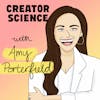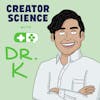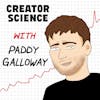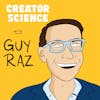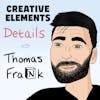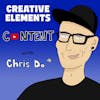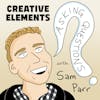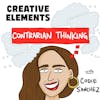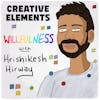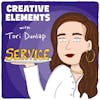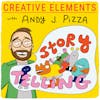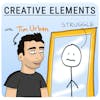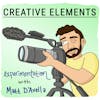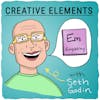
#109: Justin Welsh – How a LinkedIn legend expanded into Twitter and Email
Play EpisodeJustin Welsh has 150,000 followers on Twitter, 250,000 followers on LinkedIn, more than 35,000 subscribers to his email newsletter, and has earned more than $2M as a solo creator.
WATCH
▶️ Watch this episode on YouTube
***
EPISODE DESCRIPTION
Over the last decade, Justin Welsh has helped build two $50M+ ARR companies, teams of 150+ people, and raise over $300M in venture capital. Then, in 2019, he burned out.
Now he runs a boutique advisory firm for entrepreneurs and creates digital products for creators. He has 150,000 followers on Twitter, 250,000 followers on LinkedIn, more than 35,000 subscribers to his email newsletter, and has earned more than $2M as a solo creator.
In this episode, we talk about his approach to LinkedIn, when he decided it was time to expand to new platforms, why business can be thought of as a game, and why being Autodidactic has helped him grow quickly.
Full transcript and show notes
Follow Justin Welsh on Twitter / LinkedIn
TIMESTAMPS
00:13 - Catch up
00:48 - Today’s Guest
01:16 - Justin Welsh by the numbers
01:42 - Beginnings of Justin’s writing career
03:50 - Justin experiences burnout
04:10 - What we learn in this episode
05:18 - Early on people didn’t get it
06:04 - Is LinkedIn a practical place to start writing?
07:34 - Justin’s early experience writing
08:45 - Morning routine post blows up
10:08 - Justin’s starting expectations
11:51 - Is business a game?
19:44 - How to make a great LinkedIn Profile
21:55 - Crafting the perfect LinkedIn headline
25:30 - The Creator Funnel
28:14 - Do platforms suppress content with links?
31:30 - How should people emulate Justin today?
35:41 - Justin’s approach to social media
37:33 - Using LinkedIn to grow on Twitter
40:08 - Using awareness channels to grow
41:15 - People get weird about sales funnels
42:35 - Where are creators falling short?
46:52 - What separates the 5% from the 1%?
47:48 - When do you decide to make something a product?
51:32 - Justin’s course structure and production
54:10 - Does Justin have a team behind him?
55:10 - Justin gets very real about burnout
56:55 - Justin’s approach to networking
***
CONNECT
🙏 Make a guest or mailbag request
📝 Check out our curated Playlists
***
SPONSORS
💼 View all sponsors and offers
***
SAY THANKS
💜 Leave a review on Apple Podcasts
***
PODGLOMERATE NETWORK
This show is a part of the Podglomerate network, a company that produces, distributes, and monetizes podcasts. We encourage you to visit the website and sign up for our newsletter for more information about our shows, launches, and events. For more information on how The Podglomerate treats data, please see our Privacy Policy.
Since you're listening to Creative Elements, we'd like to suggest you also try other Podglomerate shows surrounding entrepreneurship, business, and careers like Rocketship.fm and Freelance to Founder.
Learn more about your ad choices. Visit megaphone.fm/adchoices
Justin Welsh 00:00
My whole thought process became how can I get people from point A to point B as fast as possible, as cheaply as possible. And for them to be able to finish a course in one sitting and say, I have enough information to go out and take some action to make my life better.
Jay Clouse 00:14
Hello, my friend welcome back to another episode of creative elements. Our second full episode in video. If you haven't already checked out the creative elements YouTube channel yet, please do so go to youtube.com/creative elements f m, give us a subscribe. We're doing a lot of work to make this a really great really engaging video first show I was talking with Connor this week. And my goal is to make this 60 minute interview feel as engaging as a 62nd Tick tock, which is a tall order. But if you're intrigued by that idea, be sure to go to youtube.com/creative elements FM. If you've been following the show for a while, you know that I probably have a little bit of a bias towards writing. I've been writing an email newsletter since January of 2017. I am most active on Twitter and LinkedIn when it comes to social media. And if you're in a similar boat spending time writing or on Twitter or LinkedIn, you'll probably recognize the name of today's guest. Today I'm talking with Justin Welsh. Justin has built a big name for himself over the last couple of years, beginning with LinkedIn. As of this recording, Justin has nearly 250,000 followers on LinkedIn and over 175 million impressions on the platform, not to mention some of the most impressive engagement I've ever seen somebody have on LinkedIn. And part of the reason he's seen so much success is that he's been at it since before it was cool to write on LinkedIn. You might even say that one of the reasons that it is now cool to write on LinkedIn is Justin Welsh.
Justin Welsh 01:43
One of my buddies, Kevin Dorsey who worked for me, had been writing on LinkedIn, from like 2016 on before, like people really wrote there. And he was getting a lot of attention. And I had this hypothesis that if I was going to eventually walk away from my role and try and do something on my own, or at least take a sabbatical and support myself and my family, that attention would be a good thing. And so I started writing about what I knew, I wrote about SAS sales starting in late 2018, early 2019. And it just has now been a three year journey of writing almost every single day, often multiple times a day and growing a pretty big following. But that's how it got started with watching one of my employees
Jay Clouse 02:24
do it. I think that's a powerful story, because Justin was actually following the lead of one of his employees. And it just goes to show you know, even people like Justin, we all start somewhere. And we were all inspired by someone. Now I also highlight it because before Justin was the solopreneur slash creator that we know him as today. He had a really successful career as a startup executive.
Justin Welsh 02:48
I had been in a pretty lengthy executive SAS career. So I got into tech in 2009, I worked for a really early stage startup company called ZocDoc. I was the 10th Hire there in New York City. And it was a grind, it was just really well known for being a tough place to work. And I worked there for five years. And then I turned that into a VP of sales role at a company called Patient pop in Los Angeles in 2015. For my first executive role, and I spent four and a half years there, and I grew that from its very first dollar in revenue to over 50 million in recurring build sales team from one to 140.
Jay Clouse 03:23
I actually think Justin's background has been a huge competitive advantage for him. Most of the creators that I meet don't have any quote unquote, regular career experience before they get into being a creator. And there are a lot of perks that come with that regular career experience. Justin learned sales, he learned communication, he even learned time management because he had all kinds of responsibilities. He had so many responsibilities as a leader, in fact, that it began to burn out
Justin Welsh 03:50
in 2018 ish, kind of like late 18 ish. I started to just burnout started to had been overworked for 10 years, and a lot of folks are. And I could see sort of the end in sight for just not being able to do it anymore.
Jay Clouse 04:07
So Justin has been solo since mid 2020. And in that short period of time, he's built that massive LinkedIn following. He's also begun to parlay his success into Twitter and email. He has 130,000 followers on Twitter as of this recording, and more than 30,000 email subscribers, all of which really came the last 12 months. Not only that, but he's developed two digital courses called the content O 's and the LinkedIn O 's, that have helped him earn more than $2 million as a solo creator. So in this episode, we talked about his approach to LinkedIn when he decided it was time to expand to new platforms, why business can be thought of as a game and why being autodidactic has helped him to grow quickly. I'd love to hear your thoughts on this episode. As you listen, you can find me on Twitter or Instagram at Jay Clouse. And if you're here on YouTube, say hello, leave a comment down below. Let me know what you're thinking. But now let's hear From Justin.
Justin Welsh 05:15
I think early on, a lot of the employees who worked for me didn't understand maybe what I was doing, it was actually really good for the company. Because once I started writing and Kevin had been writing, we started to recruit really well. But there was some fear around like, how would employees receive that? Would they feel like I wasn't working? Like doing stuff at work? Right? What would my boss feel like? And so part of the way that I handled that, and part of the way that I think everyone should handle things is just setting appropriate expectations. So I set the expectations with my team, I set the expectations with my boss, I built in the value of why I thought it was a good thing for the company. And so everyone really supported me in that I think a lot of folks like maybe behind the scenes probably said, like, that's weird, who's writing on LinkedIn? But all those people who sort of doubted it, in the beginning, are now people who really enjoy it, and they're trying to do it on their own. But yeah, there's always fear with doing things. But the easiest way to handle things is set appropriate expectations.
Jay Clouse 06:05
What if I'm three or four rungs down the corporate totem pole at my company, and I don't feel empowered to set expectations? is LinkedIn a practical place for me to start writing? If I do have aspirations of someday maybe having my own audience?
Justin Welsh 06:22
Yeah, it's a lot different than when I started, right? Because in 20, like late 2018, it wasn't the thing. Like there weren't really LinkedIn in for lack of a better description. And I don't generally refer to myself this way. But like thought leaders, right, like in that wasn't really a thing back then. And now everyone's on LinkedIn, and Twitter, writing a lot trying to further their career or get attention for their company. And so it's absolutely a great place to write, I think it's one of the easiest ways to share your thoughts and move your career forward, I would argue that there is always an opportunity to set expectations. The opportunity is you go to your boss, your manager, your boss, and you say it's really important for me over the course of my career to further my professional brand. And I've chosen LinkedIn, the professional platform is my platform of choice. If a boss says, Hey, you can't write on LinkedIn, first of all, it's your social media, see, do what you want with it, right. But if a boss says, You can't write on LinkedIn, as candidates market right now, I go somewhere where you can go ahead and further your career, like Dong or outreach or one of the many other SaaS companies that not only allows their employees to write on it, but advocates for it. And so that's how we think about
Jay Clouse 07:29
- So you had this teammate, Kevin, who was writing and you said, I'm going to do that. We started writing, the experience for a lot of people who start doing that is crickets just nothing? What was your first experience upon beginning to publish?
Justin Welsh 07:43
Same, I mean, I got very little engagement, almost nothing. I didn't even know how to write like, hashtags and all kinds of like, I look back at my stuff that I wrote in late 2018, like cringe, that's the whole point, right? Like, if you don't look back and cringe then you haven't grown. So I'm, I'm proud that I cringe at my early stuff. And I'm glad that I got it out of the way then. And I'm not getting it out of the way now. But eventually, I started to study how other people who are popular on social media were writing. And at the time, there was a guy named Josh factor. He had written a book called The copywriters Bible, he is sort of the father of what they what a lot of people call like LinkedIn, bro, a tree, which is like, you know, one line space, one line, space, all that stuff. And so that's what I did, like, I copied what I saw him doing. And I got a little bit more engagement. And then over the time, I realized, I didn't really like that style. I didn't feel it feels though it represented me very well. And so I started to find my own groove. And I think that's what writing everyday does is it allows you to get into a groove. And then one day, it was in either April or May of 2019. I wrote something that just exploded and was seen about a million and a half times. And it kind of blew my mind, but also showed me what was possible. And so I just took that I deconstructed it and I thought, How do I do this? As many times as possible, and that was the real start of like getting regular traction. And then over time, I've just kind of doubled and tripled down on what was working. And, you know, now here we are today, where an average, you know, post is seen probably 200,000 times and but that's compounding effort, I think, you know,
Jay Clouse 09:15
what was the idea in that post, that first post that took off? It
Justin Welsh 09:21
was a morning routine. It's like, I remember sitting and having, it's actually really funny, I got a beer with one of the partners at a venture capital firm called Toba capital, who was a backer of patient pop, the company that I worked at, and we were sitting having a beer and I remember him saying, Man on Twitter, it feels like all you got to do is write your morning routine and like it goes wild, and I just sort of stored that nugget away in my head. And when I got home, I think later that day, I'd had a couple of beers and I was like, let's crank this thing out. So I put together like it was a juxtaposition of like, what a perfect morning looks like worse versus reality. And I think it just touched a nerve. Are people really felt felt like it was creative or interesting. And therefore it, it just exploded, which is pretty interesting.
Jay Clouse 10:07
You know, you mentioned that it was crickets at the beginning and then this one finally took off. But for you to get to that point, you had some level of stick to itiveness that a lot of people don't. So did you consciously set expectations for yourself that this might not go anywhere for a while? Or do you just have that, that drive to say, I committed to this, and I'm going to see it through?
Justin Welsh 10:29
Probably a little bit of both. When I sat down to start writing, I envisioned what my business life and career would look like, if I had a million social media followers. And I had no idea what those were going to be about. But just like, I thought of that as like an incredible amount of leverage. And that if I could reach that sort of plan, by the way, it's arbitrary number, like a million doesn't matter, right? 500 1000s mazing, like 100,000 is amazing. But it was like an arbitrary number. And I had an idea that if I got there, that I would have this incredible leverage to just do whatever I wanted. And so I set sort of this goal, this Northstar, which I'm still aiming for, right, a million a million people. And again, there's no reason for it, it's just kind of a goal to shoot for. But also, like, I think a lot of people think of perseverance as a chore. Whereas I think of perseverance, as really interesting and exciting. I started at in sales at the bottom of the totem pole. And I worked my way up to being a Chief Revenue Officer at a, you know, SaaS company worth almost a billion dollars. And then I quit. And I started at the very bottom of the Creator totem pole. And I'm working my way up, and I'm getting pretty high there, right. And if I reach the top, I'll probably quit and open a brewery, like, I just think it's fun to like, try and maneuver and navigate different industries and different skill sets. And I get a lot I get a kick out of that. So a little bit of both, I think,
Jay Clouse 11:52
do you think of business as a game?
Justin Welsh 11:54
Yes. 100% I love I love the game of business. Like, to me, it's like a video game. Right? Like, it's like you unlock levels and, and you figure out new things. And I think the most interesting thing is it's not just a one player game, it's a multiplayer game. And I think the people who play business like a multiplayer game when I think if you silo yourself and it's like very much tunnel vision, it's like how do I build a business? You potentially are more likely to lose versus if you say like, how do I build this ecosystem of people that are also building businesses? And then how do we start to all intertwine our businesses together, even if at first glance, they don't appear to be relevant to one another. And I think the best players who are playing that game have unlocked sort of that multiplayer, you know, way of playing. That's how I think about it.
Jay Clouse 12:42
I like that you're being honest about calling us out. Because you know, earlier we we kind of laughed at the the term bro poetry, this this way of writing on LinkedIn that was working. And then we talked, we laughed at the morning routine comment you made, because we recognize that there are certain tried and true things that almost become trite because they work so well. Sure. And I think a lot of people recognize that and then refuse to play that card in the game, even though they know it would work. And I'd love to hear your relationship to that. Because sometimes I feel the same way. I was like, Ah, I could do this. I know how the rules of the game are played. And I could play that game. But it feels like everyone's playing that game. And I'm too cool to play that game.
Justin Welsh 13:26
Totally. So this is this is a it's first of all, it's a great question. And it really hits home for me, because, as you probably know, I recently came over to Twitter, I've been signed up to Twitter since 2009. But I hadn't actively written there until October of this past year. So I've been writing for about six months on Twitter. And when I came over to Twitter, all I heard was like LinkedIn sucks. LinkedIn is terrible. It's cringy. It's so you know, whatever. And it's like, what am I in high school, like, I don't care about being cool. I'm not trying to get a seat at the cool kids table. I'm trying to build a business. And if you want to build a business, like LinkedIn is really good place to do it. And people are always like, Oh, that's so lame. So lame. It's like, great, stay away. And I will go over there. And I will write content, and I will build a business there. And you can all be really cool. And struggle over here on Twitter. By the way, Twitter is great, too. But it's just like, I think part of my secret sauce is I just really don't care about being cool. I'm not interested in being cool. You know, I'm not a kid. So I don't I don't care about that, if that makes sense.
Jay Clouse 14:26
Totally. I feel like people they don't care about being cool, they think but then they don't make these moves because they actually do care what people are thinking what they're saying and you know I think about that Tim urban posts that I can't remember the name of course, where it has that imagery of like you on your phone caring about yourself and everyone else around you also on their phone caring about themselves. No one is actually paying that close attention to you. But we think that people are and so we prevent ourselves from capitalizing on knowledge that we have that could work you know Why not follow that style of writing on LinkedIn and take it as far as it will go? Why not repurpose some of your old stuff. And I see guys like you who really lean into it and the success you have. And then I also see the response people have. And they're, they're saying, I want that you're doing awesome. I love the work that you're doing. So even even when you play into that the response that I witness is not hey, you're not cool.
Justin Welsh 15:23
Yeah. And it's kind of interesting, because you take some of the bigger players on Twitter, right? So he'll bloom Dickey, Busch, Nicholas Cole, like whomever right folks that I've gotten to know from writing on twitter, and like, they saw what's going on on LinkedIn. And they play the game in a similar fashion, I'm speaking on their behalf. So I want to make sure that that I don't know that they play the game in this in this way. But they seem to right, my assumption is that they understand the way the game is played. And they saw traction on LinkedIn. And instead of being like, Oh, I'm too cool for that. It just instantly, they came over and now are writing and repurposing their content from Twitter, every single day, getting a ton of traction, a lot of engagement. And when I chat with those guys, like, Hey, this is pretty amazing. Like, it's pretty interesting how fast you can get traction there if you're a pretty good writer. And so again, it's like, it's kind of bucking what's cool. In, in return, what you get is a viable business, you get customers, you get a network, you get opportunities. And I think that like platforms or platforms, they're just, they're just vessels to write. And so that's how I treat them.
Jay Clouse 16:27
And I can hear some members of my audience saying, quit using the word game, this is about helping people and creating value. And that's true, these are not mutually exclusive things. I just think it's, it's helpful to think of this in the context of there are rules apparent to like this thing that we are doing, there are moves that you can make decisions, you can do chips you can play, I think it's helpful to think of it as a game in some ways.
Justin Welsh 16:53
I do too. And I don't think referring to it as a game is necessarily a negative thing. By referring to it as a game, it doesn't indicate that you mean not helping people, like part of the game is if you don't understand how to truly help people. If you don't understand how to make people's lives easier, how to make them more money, save them time, save them money, that's part of the game. And when you play the game, well like that. And if you take a look at my DMs, or my emails, like, part of the part of what I see is a lot of folks saying, Hey, I followed you, I listened to a lot of the things you said I implemented those things. And they worked, I grew a following I landed my first podcast opportunity, I got a new job I made my first dollar online, like, that's part of the game doesn't make it bad. It actually is the reverse. It's like, that's the biggest part of the game.
Jay Clouse 17:47
After a quick break, Justin and I dig into the details of his approach to LinkedIn. And later we talk about how he's transferred that success over to Twitter. So stick around, and we'll be right back. Welcome back to my conversation with Justin Welsh. Not only is Justin have more than 250,000 followers on LinkedIn, but he has some of the highest engagement that I've ever seen. Literally within seconds, yes, seconds of posting on LinkedIn, you will see multiple comments coming in flooding his ideas and his writing. So I asked Justin, how we can begin to build our own flywheel of LinkedIn engagement that way,
Justin Welsh 18:25
I kind of think of it in a way as like building a house for lack of a better analogy, but you kind of have to have the foundation in place. And to me, the foundation is just your your profile. It's like what people see when they come to interact with you and decide whether or not you're you're worth you're worthy of their time, which is essentially what they're deciding. So to me, it's like really getting the profile nice and clean. It's a it's it's making it very clear who you are, who you help, what you help them do and how you help them do it. If people can't figure that out, it becomes more difficult to commit to following someone. So cleaning the profile up nice banner image, nice headshot, a nice tagline a nice about Section featured section with your website and newsletter, things like that. I think those are all sort of standard things. I think the next thing is thinking about like, what's the one thing you want to be known for? You can't talk about sales one day, and then talk about your favorite zoo animal the next day, and then where I went with my kids. And then here's my favorite rap album and like, all over the place, what do you want to be known for? And what should your audience come to expect from you on a regular basis, and your profile should reflect that. And your content should reflect that. If you do that effectively, and you talk about the same thing. And I always say learn how to say one thing 1000 ways it's better than saying 1000 things one way. And if you can do that, you become really well known for a specific thing. And if you can become well known for a specific thing and write effectively about it, you will build a small group of followers who are interested in that particular thing. If you can do that, then you can move your career forward in whatever thing that is. So I think those are basically that's like this starting point, I think it gets a lot more robust. You can get super granular there are tricks and tips and you know, quote unquote hacks for lack of a better description. But that's the starting point for me.
Jay Clouse 20:09
How should I think about my headline because I think that's one of the most impactful out of the box things that I can edit when I land here. And you could easily show in your headline, like, founder of Justin, watch, whatever you have, as your experience here, founder of Justin Welsh, self employed or something along the lines of like, creator, but you have almost like a mission here. So how do you think about the headline,
Justin Welsh 20:31
I don't think that there is an objectively right way to write it. It's funny, my newsletter this Saturday actually is covering this very topic. But again, there's not like a right way to do it. But I think generally, it falls into a few different camps. One is, is just like, what do you do? Basically, like, what do you do for whom and how I think that's a really interesting thing, like, like CEO at company or account executive at here, or software developer at here is not meaningful or beneficial that anybody in your audience who's considering following you and tells them nothing of value? You can also find that in the experience section, so there's no need to repeat that. I think you have to give people a compelling reason to follow you. So again, who do I help? What do I help them do? And how do I help them do it? Or if I follow you, what will I get? So I write posts about X, right? Or follow me for more of why like, that's another way to sort of do it, I chose a third way, which is, I wanted to give people an interesting mission that I was on. And for them to see that mission and say this is a mission that I want to follow. So I chose building a portfolio of one person businesses to $5 million in revenue. To me, that's like, to me, it's interesting. And if people find that to be interesting that I'm a person that you want to follow. And because I think we're in the midst of again, using some cliche words, like great resignation, and all this stuff, I think learning how to go out and build your own business, you're a one person business is interesting to a lot of people. And so my hope is when they see that tagline, they'll be compelled to follow
Jay Clouse 21:56
for people who haven't been on LinkedIn in a while. And that's actually probably true. For a lot of folks listening to this, you might not realize that when you post something your headline is actually seen below your name, it's pretty differentiated on LinkedIn versus other platforms, as you get this, this headline, this calling card underneath your name when you show up in the feed. So it is important because this is really, you know, say this pops up in somebody's feed. And they're not connected to you. And they see this like, Oh, who's this guy? Like, I feel like that's the thought I have, as I'm going through my feed and seeing new things like who's this guy, and you write the title? It's kind of there's like some social proof there if your title is pretty sexy and high level, but again, it's not really showing me how you're going to help me it's just showing me how seriously to take you in a way.
Justin Welsh 22:39
Yeah. And you can you can use it to say how am I going to help someone, I do think like I teach X to do Y through Z is getting a little bit overused. And so although I think that's a clear way to make a point, I just wanted to be different. So one thing that people don't realize, what you pointed out is that it's underneath your name, anytime you post, it's also underneath your name anytime that you comment. And so that also provides a lot of sort of awareness as I go around and make hopefully what are seen as intelligent comments on other big and popular creators on LinkedIn. I like to comment on their stuff. And when people see my tagline, my hope is again, that they feel compelled to follow me. But because they feature that it's kind of a creators dream. In a way, there's plenty of things that are a creators nightmare about LinkedIn. But that is one that I love about the platform.
Jay Clouse 23:29
I agree. I agree. Okay, so you mentioned having a good profile photo, which seems obvious, but it's also missed, I find on all platforms, not not thinking about your profile photo that much, who you can help how you can help them. One thing that I think you do really well is now that you've employed a newsletter, your LinkedIn audience, you are moving to other places within your your ecosystem. Can you talk a little bit about that?
Justin Welsh 23:57
Yeah, I, I kind of came up with this idea of something that I call the Creator funnel, that is really thinking through like, how do people make decisions? How to how do people make decisions in today's like, modern era? And I thought through how I make decisions, for the most part, what have I bought? Who do I interact with? And what are the steps that I've gone through. So it kind of boils down to a few different things. There's awareness or discovery, like discovering that somebody exists, and that they're interesting. That's sort of step number one, and most people discover or become aware of a creator through short form social media, whether that's Twitter or LinkedIn, or Instagram or YouTube or whatever. And then I think once you sort of become aware of somebody, one sort of key turning point in the calling it a relationship is starting to trust that person, but not trust in a way like I want this person to babysit my kids or look after my house. It's more of like, trust in a way that this person knows what they're talking about. And so to me a newsletter Letter is an opportunity to show how my brain works and how I think about things at a much deeper level. And so the intention of the newsletter is is twofold. It is to show how I think at a deeper level and build that trust with my audience. And it's also meant to D platform users off of places like LinkedIn and Twitter and into an email address that I own. So that's that's obviously really important. So once you once you are showing people how you think at a deeper level, the next part of the Creator funnel is deepening the relationship. And this is tied to a lot of what you hear about community led growth, you see a lot of that on Twitter, on people talking about that on LinkedIn. And that's giving access to you. It's one on one access, it's coaching calls, it is doing events, it's going and doing things in person. And so I have a private community of about 700 members across 57 countries. And not only do we run events and chat with people on Slack every day, but my wife and I have also gone to New York, London, San Francisco, LA Lisbon, Madrid and thrown happy hours get togethers. And this is deepening that relationship. Number one, it's cool to meet really interesting people. But number two, once that relationship is really deep, they're just much more likely to continue to be a customer of your business. And so I think of that awareness and discovery at the top, trust building in the middle, and then relationship deepening in the end. And I think if you do those things really effectively, you're able to build a really great business. And that's sort of the thought process behind getting that newsletter started.
Jay Clouse 26:29
The frustration that I hear amongst a lot of creators is they understand that social media, these borrowed platforms, they're great discovery engines, but they want to get people into an ecosystem that they can control more like email, email is a great example. Podcasting is actually another good example, for sure. And it's hard to do because these platforms equally or incentivized to not let you do that, or not want you to do that. And it seems like when you post a link somewhere, those platforms will often dampen the reach of those posts. One, I want to know if you have seen that and believe that to be true.
Justin Welsh 27:02
Yes, I mean, for sure. If you throw LinkedIn or LinkedIn post or Twitter, you know or tweet, it's just it dampens it for sure. There are hacks and tricks around that right, there's the first comment on LinkedIn, there's driving people to your featured section, there's the new LinkedIn, the top of the LinkedIn profile, which was rolled out last week, if you see right below, sort of where I live, it says in Nashville there it says grow and monetize your LinkedIn. That is a new feature where you can link to products or services. So yeah, I see that for sure. There's just you got to be creative, you got to find ways around platforms trying to work against you. And that's, you know, copy what other people are doing.
Jay Clouse 27:37
Yeah, I this is one of the things I've taken from you one your your Saturday solopreneur issue talking about this link in the LinkedIn bio new feature didn't realize it's out there. It's not like they released it with a ton of fanfare, I'm kind of surprised put it in there at all, to be honest. So I was glad to get that in your newsletter, I see you making good use of your featured section, as you said, because I would imagine the the journey for a lot of people, if they aren't already following your work, and it pops into their feed as a second or third degree connection. They're gonna say, Who is this guy? Like we said, they're gonna look at your headline, then they might visit your profile. And then you know, the game is how do you actually get them to move to your website from your profile. And now this is one more way to do it with a link in your bio. But you mentioned the featured section here that's fairly new, and even below, in your experience you can have links to so I see you're doing all three of those. And I posted about this and in our community, one of your posts that you put recently, you kind of teased an upcoming issue of the newsletter, and you put in the post join 19,227 subscribers at Justin Welsh brackets.me. So it's not a link in there. But a brilliant way to get around that do you find that this is effective?
Justin Welsh 28:52
Very, very effective. I usually, every Friday, I tease out the next newsletter with sort of a TLDR of what's coming, and then I'll kind of do like, subscribe, there's a few different ways you can subscribe, you can go to Justin welsh.me. And I'll bracket the dot, you can find the link in the first comments, or you can visit my featured section that gives people three different ways to subscribe, right. And then on Twitter, I'll do the same thing. Every Friday, I'll pre sell my upcoming newsletter issue. And then once the newsletter is published, I'll post sell it. So I'll go out and say 23,955 People just learn the top four tips for improving their social media profiles. And I try and use a lot of numbers I feel like that always generally gets people interested and excited. And that has been really a great and fast way to grow my newsletter. Now I have a lot of followers, right. So like if you have no followers, it's not going to be as easy. But I've been able to grow it up to now almost 25,000 subscribers in 90 days.
Jay Clouse 29:47
wild crazy crazy crazy how fast you can move into new platforms and I'd love to talk about that actually, strategically. And this may be the benefit of hindsight. But a lot of people they'll they'll start modeling after what they See of Justin today, they'll see Justin's doing LinkedIn. He's doing Twitter. He has courses, he has a newsletter, and they're getting started. So they decide I'm going to do all of those things right out of the gates, right? Talk to me about how you would recommend people go about trying to emulate your journey. If they are starting today.
Justin Welsh 30:19
I'm a huge like, I bring a lot of what I learned as a chief revenue officer into being a creator. And so most of what I think about is processing systems and understanding why things work. And so if you're somebody who has 10 followers on a social media platform, and you come and you write the same thing that I write, it's not going to work. Because I have more brand recognition. It's why I can't take something to vol rights, and copy and paste it and get the same reaction he does, right. That's not how the game is played. If you want to really understand how to figure out where how I got to where I am, or how Sahil bloom grew to 560,000 followers or how anybody grew to having these large followers, I like to go back to the beginning and deconstruct. So as I was getting ready to go on to Twitter, one thing that I did is like my eye, I caught in my eye, this really cool issue from trends.co, where it broke down to heal blooms growth from zero to 560. And that gave me an idea, which was, why don't I go back and figure out how all of my favorite creators grew to be so big from the beginning. Why don't I go back to like when they were basically at no attention and deconstruct all the things that worked for them. So like, what was Dickie Bush writing before he was popular that that actually worked in like God, him his ascension? And so I'll go back and deconstruct all that stuff and use that and then reconstruct it for my topic. I love stealing things that work, right? That's sort of number one, I would recommend, like just doing a lot of diligence and studying, all the answers are there, all you have to do is have the time to go figure it out. But I would focus on the primary driver of the funnel, which is awareness. And everyone wants to build trust, and monetize and get a community and sell a product and do coaching and all this stuff. And it's like, just play the game. And the game is really long. And so the longer you can play it, where you're in the awareness phase, and you're not selling anything, you're just making people aware and building trust, those are the two most important things. If I could go back to the beginning, like I probably would have played that game even longer before I created my first product or my first service. Because if you can wait it out, and you're financially stable, and you're able to do so the leverage you have, as you grow a large following of the right people is so so incredible. And so I would just say like stick to growing that awareness and that trust before you monetize or build a community or anything like that.
Jay Clouse 32:45
When we come back, Justin, and I talk about his overall approach to social media, and how he was able to translate his LinkedIn Success over to Twitter and email right after this. Hey, welcome back. Back in episode number 97 of the show, Dickey bush and I talked about how he was able to translate his Twitter success over to LinkedIn. But Justin has taken the opposite approach. He started on LinkedIn. And now he's transitioned over to Twitter. So I asked him to walk me through his overall approach to social media.
Justin Welsh 33:14
The way that I think about it is pick one platform that you like to be on. So the biggest thing I see is like I heard Tik Tok is popular. Should I be on it? Well, do you like doing videos? No, the No. Like, do what you like to do. I like to write. And so I chose LinkedIn, because it was a heavy writing platform back in the day, I thought of Twitter is like the place I went to get news. So I didn't think of it as like a creator platform back in the day. And so I just happen to choose LinkedIn. And I write every day because I like to write and therefore I'm more likely to stay consistent. And so I'd say, pick a platform that matches with the things that you really, truly enjoy doing. And by doing that, you improve your likelihood of being consistent. And then once you understand deeply the nuances of a platform, and you've kind of mastered it. And there will be a point where you're like, I've got this, I know how to create content that's going to be really popular for this platform, do it take advantage of the fact that by creating popular content every day, you'll continue to grow. But at some point, you'll reach sort of an invisible ceiling, which is what I did with LinkedIn, where it's like, I know how to get almost 200,000 impressions on everything I write. And I wanted to unlock a new platform. But I spent two and a half years on LinkedIn without any other platform expertise, move to Twitter. And all the things I learned over the last two and a half years, while different, were still applicable. And so it was easier for me to go over there and figure that out much faster. Versus had I tried to master LinkedIn, Twitter, Instagram, YouTube Tiktok, which by the way, I tried all those things, and it was kind of a nightmare.
Jay Clouse 34:48
And you were actually able to use LinkedIn to grow your Twitter. Can you talk a little bit about how you kick started your Twitter profile with LinkedIn?
Justin Welsh 34:58
Yeah, so There's a couple of really interesting ways to do that, which is I kind of like siphon my, my LinkedIn on audience early on and move them over to Twitter. One way I did that is LinkedIn has a newsletter feature. And that newsletter features can be accessed by anybody. And when you create your first LinkedIn newsletter, they will promote it one time, which means they will send it out to everybody you're connected with and say, Justin Welsh has started a newsletter. They won't promote it after that. But you'll get a tremendous number of signups the first time they promote it if you have a large following. And what I really like is it goes both on the LinkedIn feed, but it also gets delivered into their inbox via LinkedIn. So it's sort of like an email newsletter, but you don't own the emails. And so what I did was I had 50,000, LinkedIn newsletter subscribers early on. And so what I would do is I would write a short form piece of content as the newsletter, and then link to a tweet thread that continued what I was writing inside of that. So I'd pull 50,000 people out of their inbox and into a tweet thread. And that was able for me to sort of get that tweet thread moving. And what the tweet thread did was then exploded. And it went out to people who had no idea who I was, because I was using the energy from my one platform to get the content to grow on another platform and therefore be exposed to people who have never heard of me. And so that was a really good way to make quick work of growing on Twitter early, you can do that on a regular LinkedIn post on a newsletter, I try as hard as possible everywhere that I have some sort of following, to direct them to another place where they can have a touch point for me. My thought process is some people will like LinkedIn, some will like Twitter, and some are like the newsletter, others will like two of those three, and others will like all three of those things. And so my goal is to play wherever people want to see me and be sort of everywhere now. But I don't recommend that from the beginning.
Jay Clouse 36:57
Yeah, that's the type of restraint that I wish I could go back and give myself but especially if people listen to this now who are who are getting started, because the leverage, you had to be able to take that LinkedIn audience and get them started on Twitter is just infinitely more impactful than trying to start LinkedIn, start Twitter, start a newsletter, do all three out of the gates at once and try to grow all three at once. Something I saw Sahil bloom do really well, also is like, when I watched his story, what I learned was, the best way to grow an email newsletter is not writing emails. Not to say that you'd never write emails, but like, that's not the lever to pull to get more email subscribers to actually these awareness channels that you're talking about that you can build bigger followings there, because the frictions lower to get started tuning into what you're saying. And then over time, leverage that and siphon them into email or elsewhere.
Justin Welsh 37:54
Totally. And you also have established fans. So what happens is when you release your newsletter, and you've got 300,000 followers on a platform, maybe only 25,000 or 30,000, show up or subscribe, maybe less, but they're so used to consuming what you create. And they're so used to talking about what you create that the nice thing is, whenever I produce a newsletter on Saturday, somebody somewhere on some platform is generally saying something nice about it. And that helps not just spread the word. But also get people from the awareness to the trust step much faster when it comes recommended by somebody else.
Jay Clouse 38:31
I love the the sales language using awareness trust, what other levels you have in your your Creator, Salesforce, yeah,
Justin Welsh 38:39
just deepening the relationships. And then the last one is basically monetization. And like, I walk people through this funnel, and they say things like, Oh, it's so weird that you have like a game plan to get people to be customers. Welcome to marketing,
Jay Clouse 38:54
it seems like it'd be weird in a
Justin Welsh 38:56
way like it is people people feel so strange about the fact that like, I'm open about the fact that I'm moving people through a funnel. It's if you think that's weird, wait to see Budweiser commercials of guys with six pack abs playing volleyball, like marketing is is intended to do things that are not always as authentic as supposedly marketing is. But I try and be open and transparent about it. Right? I try and say like, everything that I create, my goal is to get customers, because that's what I do for a living. Now I also make friends, build a network help people build their own businesses, like there is of course an element of helping other people or else I wouldn't be very popular online, right? But the end game is this is I'm running a business and I'm building a business and I'm really, really, really transparent about that.
Jay Clouse 39:48
I'm gonna go back to something you said a little bit ago which was, you know, we're talking about focusing on one platform and picking one you like and doing that for two and a half years was Was your journey. You can hear that and see seems really simple. But you could spend two and a half years on a platform, quote unquote, air quotes here and not have any results at all. And I think a lot of people do that. So what is what is the difference between somebody who is truly doing this for two and a half years versus somebody who thinks they are, but they're not getting any results? Where do you think they're falling? Short?
Justin Welsh 40:20
I think there's a lot of places that people particular or potentially fall short, I think one of them in by the way, this will probably start not an argument, but there are different takes on this topic. I think one is, they're just not niche enough. I know people like oh, you don't have to have a nice, you can just be interesting. Maybe, but I think it helps to talk about something specific. And a lot of times, I'll ask people on LinkedIn or Twitter, like, give me your Give me your pitch? Who are you? Who do you help them? What are you gonna do? I'm Joe and I help small businesses grow? What does that mean? The Plumber down the street, the pizza shop, and early stage startup company. Those are all very different small businesses like who do you help? And what do you actually help them do? And so I think people talk about these very nebulous sort of business ideas or coaching ideas, and it's, they become a commodity. It's a commodity content, right? Everyone can talk about helping small businesses. But if you talk about a very, very narrow and specific topic, then instead of being a commodity, you become the only and you become the only person the only choice or one of very few choices. So I think the first one is like getting very narrow about who you help, what you help them do and how you help them do it. The more specific you can get, the more that a business or a company or a person can self select in or out about your content, the better off you are, people should go to your profile or your content and either make one of two choices. Justin Walsh's content is 100% aimed at me, or Justin Walsh's content is 100% non for me. If it's like, I'm not sure if this guy's content is for me, then you're losing already. So I think that's the very first thing that I see people really struggling with is being way too broad and way too nebulous, nebulous. The second thing that I see people struggle with is they don't actually get better at their craft. It's a hobby, and they don't put in sort of the reps, which is they've been writing for two and a half years. But they haven't picked up a book on copywriting. They haven't gone back and broken down to other creators, format structures and styles. They haven't, you know, studied Marketing examples.com, one of my favorite websites from Harry dry, they don't read very good copy.com from Eddie Shlain. Or like, they don't dive into the world of understanding how to write creative and compelling copy. And if you just keep producing the same style every day, and it never resonates, you're just doing the same thing over and over and over again without getting any sort of results. So it's not being specific or niche. It's not really making this a craft of yours, treating it like a job, you know, if you can find the time to do so. I think that's really important. And then I think the third thing that I see is just not really understanding how the game is played from a networking perspective. A lot of these folks who want to grow their brand, like they don't interact with me and at all, and then I'll get one piece of interaction. It's like, Can I pick your brain for 60 minutes? And I'm a nice guy. So sometimes I say yes, but for the most part, I get 100 of those a day. So it's really difficult to say yes to things like that, versus understanding the give and take the value add of playing on on social media. Online is a lot like offline. If you can understand how networking is done offline, you'll probably be pretty good at it online. And again, it's doing diligence, learning how that's done studying it. I think it's just the answer is work. Right, like to encapsulate all that stuff, it's like, work
Jay Clouse 43:41
well at work. The word that comes to mind for me is like rigor, you know, where it's not like it's not like aimless effort. It's it's very much like strategic and aimed at improvement and analytical like looking at your own stuff being critical with your own stuff. Because all the things you've described are like being a student of the craft, and using that to make your work better and better and better. Somebody on Twitter, Max asked us, you know, what separates the top 5% from the 1%. And we had similar in answers of really putting in the extra deck. Again, work is kind of the answer, like putting in the extra effort.
Justin Welsh 44:21
Yeah, I saw that question come through. And like, one thing that's really obvious is when people are talking a good game, versus like, someone went out figured out how to do something really difficult and complicated, came back to Twitter or LinkedIn, and shared all their learnings in a really simple and cohesive manner. The second part, sharing things in a simple and cohesive manner that may otherwise appear complicated is helpful. But the first part is more helpful, actually going out and figuring out how that thing is done and then doing it. That's what makes for interesting content. So people are like, how do you come up with content? It's like, do interesting things offline to be interesting online. And that's a really easy way to come up with con Tennis, if you're constantly doing interesting and complex things you mentioned,
Jay Clouse 45:03
you know, if you go back, you would play the game even longer of waiting to monetize with a product. You have two products now, you give so much in your content. How do you decide when it's time to wrap something together as a discrete purchasable product?
Justin Welsh 45:22
I don't generally generally my audience does. So I'll give you some examples. Before I had released the operating system. I went through my DMs and I noticed a trend in a trend was, hey, man bought your LinkedIn playbook. A lot of people don't know I had a product a long time ago is $50. It's like, Hey, I bought this in 2019. I released a product earlier, maybe early 2020. I wish I didn't. But a lot of people liked it. And they wrote to me, like all the sudden, hey, this isn't super applicable anymore. This is a little old, like this stuff. are you releasing a new one? Are you really seeing the one? are you releasing a new one? are you releasing a new one, every single day, I was getting emails and DMS. So I was like, Oh, this is an indicator that people are interested in a new one. And so I'll take that indicator, and then I'll use that to pre sell. So I never build anything unless I make a certain amount of money on it. And I'll go out and say this is coming in 45 days, like it's on sale right now grab it. And as soon as I cross the threshold, I'll go out and build it. There's no sense in building a new product if no one wants it. And so that's like one way of looking. And then my second product actually came out of a ship third ship 30 for 30 podcast where I went on with the key bush and Nicolas Cole. And I was just kind of showing my back end system for how I create process and structure for content. Yeah, educate me motivate me make me think empathize with me newsletter follow up. You know, they're probably some different ones and some different places. Yeah, newsletter tees, previous week's newsletter. Like, I don't want to have to think when I'm creating like, I want to take all the thought process out of it. The next thing that I'll do is I'll say like, alright, Monday am empathize with me. So I'll go into my content matrix. And I'll be like, Alright, here's the empathize me column. Here's all the different things that I talked about. So I want to talk about the nine to five, right? I like to throw rocks at the nine to five as it's my enemy, right? So I'm going to empathize with people about the nine to five. Cool. So let's do that. So let's go into my templates. And let's go and pick one of my top one of my templates, right? This topic is dying, pop it open. Right? The topic is strong negative word, the opposite is strong, positive statement. And I love it. Why? Tired of crappy thing? 12345 This is something that I can literally fill out. So when I filled this out, here's what happens. Right? The nine to five is getting pummeled strong negative word, the great resignation is growing faster than ever. The opposite is strong, positive statement, right? Well, that's why this has 2.4 million likes this makes me so happy. I love this. And everyone's eyes kind of like lit up and Dickie was really taken aback by the by the system. And then I got a ton of people emailed me after that podcast episode, who said, could you share that? Could you share that? I'd love to, is that a product? Do you have that? And I was like, Oh, here's more indicators of a potentially new product. So I pre sold it pre sold it well built it shipped it. Once I had shipped it. People were like, This is awesome. I really enjoy this great, great product. I have to build my own templates, though, do you just have any templates that you like have and I was like, that sounds like a new product. So I created a One Click Upsell Mr. product called the monthly templates. I noticed that people were selling those online anyway. And they're charging a fortune. So I'm like, Oh, here's $9 a month, that's I'll undercut everybody else and deliver it at 10x value. And so that's what I did. And that became a $9,000 MRR product in 45 days. And so that's how I think about building products. It's not what I want, doesn't matter what I want. What matters is what the customers want.
Jay Clouse 48:47
Something that I found really empowering as a creator myself in watching and going through your course the content operating system, I had a preconceived notion of what courses look like, and I hope you don't take offense to this. I expected I expect a course to be like super high production value slides, animations, overtures, you come out and right away, you're like, this isn't about that, actually, I'm going to teach you a very simple thing. And I'm going to do it as efficiently as I can. And you deliver on that. And at the end of it. I'm like, great, that's what I needed. And I do want that efficiently. So talk to me about that decision. Because I think a lot of people get held up in the, the perfection, high production expectations they think people have
Justin Welsh 49:30
you know, it's it came from again, thinking about myself, like how do I like to consume? So I make an assumption that people are like me, which by the way, is a bad assumption and probably shouldn't be made by other people. But that's what I that's how I think I'm like, What do I like to consume? How do I buy How do I like to watch courses? And as I was trying to figure out social media back in like 2017 2018 I was so clueless I couldn't figure it out. And I came across this interesting guy named Chris Johnson on Twitter. I think he goes by like wealth squad Chris or something. Now he's got like, 400 or 1000 social media followers, he's the highest paid creator on Gumroad. Like, Oh, really? Yeah, I mean, I talked to Sylvania, confirm that he makes a ton of money on Gumroad. And I was like, How is this guy doing all this, like, this is incredible. So I went into his profile, and he was selling these low cost courses on how to grow on Twitter and how to do all these other things. He's He's since transitioned into different niches and things like that. But I bought one of his courses, it was $40. I was like, Oh, this is a no brainer. So I bought it. And like, it's just him in like his apartment on Zoom. And with like, white and black slides, and in 40 minutes, I had like a good structure and foundation for like trying to go out and understand Twitter. And I was like, Oh, that was really cool. Versus like, people used to come to me and be like, have you seen Sam ovens consulting accelerator? And I was like, I don't know what that is. And like, it's cool. It's like seven hours long. I was like, I don't have seven hours. I don't, I don't want to watch anything. I only want to watch a good movie for seven hours. Why would I want to do this? So my whole thought process became how can I get people from point A to point B as fast as possible, as cheaply as possible. And for them to be able to finish a course in one sitting and say, I have enough information to go out and take some action to make my life better. And so I keep it cheap, because I don't rent out private planes or skyscrapers or beach and try and pretend that I'm cooler, hipper, richer than I am, like, I just sit in my office here in Nashville and record on Zoom. And to me, that's just it's easy to ship fast and like make it cheap that way.
Jay Clouse 51:27
Do you have a supporting team?
Justin Welsh 51:30
I just got my first supporting. Well, my wife would be remiss if I didn't if I didn't say yes. And my wife is a huge support system for my business, really our business. So my wife helps a lot specially with the community. But to answer your question, what I'm talking about is like traditional employees, I have zero traditional employees. But for now, six weeks ago, I hired my first virtual assistant. So I was just getting blown up via email, LinkedIn, DMS, Twitter, DMS. And I just found myself context switching constantly. And increasing the creative role we're writing is the thing that drives my business, like I have to stay focused. And so I hired my first virtual assistant from virtual. And she's amazing. I wish I would have done it so much earlier. And I actually just wrote a thread about it on Twitter the other day on how we built this system to work together really effectively. But she's been a dream.
Jay Clouse 52:25
How were you able to put that off for so long?
Justin Welsh 52:29
I can give you like, the fake answer, or the real answer, I think, is probably the best one, which is I'm a workaholic, I think people think that I write a LinkedIn and a Twitter post every day, and then go hang out and like, have fun. It couldn't be any further from the truth. I'm on the computer, generally from six in the morning till about seven o'clock at night, which is not good. Right. But that's the truth. And so I like to work. I've always like to work. I don't mind working really, really, really long, extended periods of time on my own stuff. I don't love working 15 hour days for somebody else. But I don't mind working 15 hour days for myself. And so the way that I did it is just brute force. And what I saw happening, I was going down the same path that I had gone down at my previous job, from workaholism, which is gaining a lot of weight, drinking a lot of alcohol, sleeping really poorly, not making good decisions. And I didn't want that to happen again. Rather than go further down that rabbit hole than I should. I just decided, now's the time, invest money, invest time, get a help. And that's what I did.
Jay Clouse 53:47
Really appreciate your honesty. Because I think that's that's the case for a lot of people who don't own up to it. It's also the case for a lot of people that they may be independently wealthy when they start this. Some people, there's always some story that isn't necessarily disclosed. And people don't realize the trade off that people are making to make some of this stuff go. In your conversation, that conversation that you had, I think it was the one with Nicolas Cole and Tiki bush on on their podcast, you talked a little bit about your approach to networking. It's kind of
Justin Welsh 54:18
like a, I don't want to use the wrong word here. So I'm not going to try that. It's like a system right? Where there's like different tiers, right, like, Okay, I'm zero to 5000 5000 to 15,000 followers, right? Doesn't mean you're a better smarter person, the more followers you have, in fact, some people with a lot of followers, I don't think are that smart at all. But there is like a quantifiable thing there. You can look at somebody's other someone else's Twitter account and be like that person has x followers, you can see that it's tangible. So what I tried to do is as I grew, I tried to connect with people who were at a relatively similar level to me in terms of followers. I felt like I wouldn't get big time they wouldn't be too busy. Like I I'm not the kind of guy who has 800 followers on Twitter and is going to reach out to navall Raava Khan, right. Like I, I know there are people who will do that I'm not that guy. So all I did was connect with people who I thought were interesting in creating useful and valuable content. At my level, for lack of a better description that allowed me to have more comfortable conversations. It allowed me to learn what they were doing, you know, learn their audience, learn their network, become part of their ecosystem support their content, they supported mine. And as I moved up, I made connections with guys like you
Jay Clouse 55:33
in your week. How much time are you spending, having calls with people that are potential collaborators, not necessarily like customers and things like that, but potential future collaborators or even just friends?
Justin Welsh 55:46
I probably do three to five of those every week. So this morning, I went out and met a venture capitalists used to be a linebacker for the bears. He's here in Nashville, really cool guy to know, runs a VC accelerator for former and current athletes, and just like got connected with him and a happy hour and just went out to where he was at to meet for coffee because he's a nice and interesting dude. And I think there's some overlap. And what we do did that this morning, yesterday, I connected with Jacob McMillan, who's pretty well known on on Twitter a couple of weeks previous. Dan co I'm connecting with Eddie Schlanger. Next week, I had Josh Spector on my event yesterday, and just like constantly, maybe maybe even more than three to five times because this isn't like a one man sport. Like we talked about earlier. This is a team game. And I feel like I could continue to write for my audience. And that's cool. And I'll continue to do that. But actually connecting with the saw hills of the world, the Dickies the Dan COEs, the Josh specters like, that's actually really good gasoline to your fire. And also, by the way, like, I don't look at everything as transactional. It's also just really cool guys. Like, I just like to talk to them and like they're interesting and smart. And so part of what I've tried to do throughout my whole career is try my hardest to be around people who are smarter than I am, or who bring just different skills to the table than I have and learn as much as I can from them. So super important.
Jay Clouse 57:17
We covered a lot of ground in this episode, and I love Justin's very practical, very honest approach. You can almost hear his experience leading teams in his former life because he thinks in sounds like a leader and a salesman, frankly, not the skeevy used car salesman but someone who is focused on creating value and being able to message that value to potential customers. If you wanna learn more about Justin you can visit his website Justin welsh.me or on Twitter at the Justin Welsh or on LinkedIn by searching for Justin Welsh. Links to all of those are in the show notes and if you want to try out Justin's courses, the content OH S or LinkedIn OS I highly recommend the content OH S. I have an affiliate link in the show notes as well. Not only we learn a ton but you'll be supporting the show and the process. Thanks to Justin for being on the show. Thank you to Connor Connor boy for editing the video for this episode. Thanks to Emily Klaus for making the artwork for this episode and Nathan Todhunter for editing the audio. Thank you Brian scale for creating our music. Thank you, Austin sailor for creating our opening animation. If you liked this episode, you can tweet at Jay Clouse and let me know and if you really want to say thank you, please leave a review on Apple podcasts or Spotify. Thanks for listening, and I'll talk to you next week. A Sonic universe
Most Popular Episodes
New to the show? Check out some of our most popular episodes.






